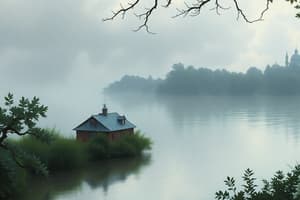Podcast
Questions and Answers
What does Mise-en-Scène staging refer to in film?
What does Mise-en-Scène staging refer to in film?
- Elements related to sound production
- Elements of post-production editing
- Elements behind the camera
- Elements in front of the camera (correct)
Which of the following is NOT an element of Mise-en-Scène staging?
Which of the following is NOT an element of Mise-en-Scène staging?
- Set design
- Costume/Hair/Makeup
- Soundtrack composition (correct)
- Lighting quality
What is the purpose of 3 point lighting in Mise-en-Scène staging?
What is the purpose of 3 point lighting in Mise-en-Scène staging?
- To create balanced lighting on the subject (correct)
- To create dramatic and high contrast lighting
- To emphasize the background setting
- To achieve low key lighting effects
What does 'Hitchcock’s Rule' refer to in Mise-en-Scène staging?
What does 'Hitchcock’s Rule' refer to in Mise-en-Scène staging?
What does 'High key versus low key' refer to in Mise-en-Scène staging?
What does 'High key versus low key' refer to in Mise-en-Scène staging?
Flashcards are hidden until you start studying
Study Notes
Mise-en-Scène Staging
- Mise-en-Scène staging refers to the arrangement of everything within a scene, including actors, props, setting, and camera placement.
Elements of Mise-en-Scène Staging
- Elements of Mise-en-Scène staging include:
- Setting (location, time period, and atmosphere)
- Props (objects that actors use or interact with)
- Lighting (type and placement of lights)
- Costume (characters' clothing and accessories)
- Makeup and hair
- Body language and facial expressions
- Camera placement and movement
Excluded Elements of Mise-en-Scène Staging
- Sound design is not an element of Mise-en-Scène staging.
3 Point Lighting
- The purpose of 3 point lighting in Mise-en-Scène staging is to create a visually appealing and balanced lighting effect by using three lights:
- Key light (main light source)
- Fill light (softens shadows)
- Backlight (separates subject from background)
Hitchcock's Rule
- Hitchcock's Rule refers to the principle that the size of an object in a scene should be proportional to its importance in the story.
High Key vs Low Key
- High key refers to bright, evenly lit scenes with minimal shadows, often used to create a happy or optimistic mood.
- Low key refers to dark, contrasty scenes with prominent shadows, often used to create a dramatic or suspenseful mood.
Studying That Suits You
Use AI to generate personalized quizzes and flashcards to suit your learning preferences.




